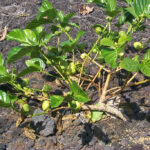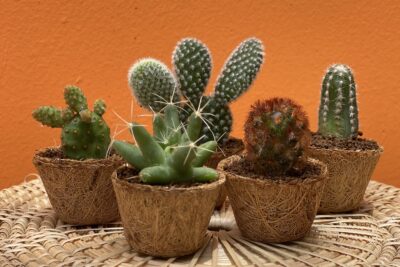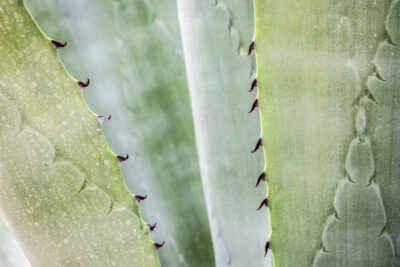
Succulent Care on Wood: A Guide to Proper Maintenance

Succulents have become increasingly popular in recent years due to their unique and low-maintenance nature. These plants are known for their ability to store water in their leaves, making them highly adaptable to various environments. One creative way to display succulents is by planting them on wood, such as driftwood or tree branches. This not only adds an organic and rustic touch to your space, but also provides a natural and beautiful backdrop for your plants.
We will explore the art of succulent care on wood and provide you with a comprehensive guide to ensure proper maintenance. We will discuss the benefits and considerations of planting succulents on wood, as well as the necessary steps to create a suitable environment for your plants. Additionally, we will delve into specific care instructions, including watering techniques, light requirements, and potential challenges you may encounter. Whether you are a seasoned succulent enthusiast or a beginner looking to incorporate these trendy plants into your home, this guide will equip you with the knowledge and skills to successfully care for your succulents on wood.
- Choose a wood surface that is suitable for succulents
- Place a layer of pebbles or stones on the wood to improve drainage
- Use a well-draining soil mix specifically formulated for succulents
- Water your succulents sparingly, allowing the soil to dry out between waterings
- Provide adequate sunlight for your succulents by placing them in a bright location
- Rotate your succulents regularly to ensure even growth and prevent leaning towards the light
- Avoid overwatering or leaving your succulents in standing water, as this can cause root rot
- Maintain a consistent temperature and humidity level for your succulents
- Monitor your succulents for pests and treat them promptly if necessary
- Prune your succulents as needed to remove dead or damaged leaves and promote healthy growth
- Frequently Asked Questions
Choose a wood surface that is suitable for succulents
When it comes to displaying your succulents on a wood surface, it is essential to choose the right type of wood. Opt for a surface that is durable and resistant to moisture. Hardwoods such as cedar, teak, or redwood are excellent choices as they are more resistant to rot and decay. Avoid using softwoods like pine or fir as they tend to absorb moisture more easily, which can lead to damage.
Additionally, ensure that the wood surface is properly treated or sealed to protect it from water damage. A water-resistant sealant or a layer of polyurethane can help prevent water from seeping into the wood and causing it to warp or rot over time.
Provide proper drainage for your succulents
One of the most critical aspects of succulent care on wood is ensuring proper drainage. Succulents are highly susceptible to root rot if their roots are constantly sitting in water. To avoid this, make sure that your wood surface has adequate drainage holes.
If you are using a wooden planter or box, drill several drainage holes in the bottom to allow excess water to escape. This will prevent water from pooling at the bottom and potentially causing damage to the wood or your succulents.
Use a well-draining soil mix
Succulents thrive in well-draining soil that allows water to pass through easily. When displaying them on a wood surface, it is crucial to use a suitable soil mix that promotes proper drainage.
 Reviving an Overwatered Succulent: Tips to Save Your Plant
Reviving an Overwatered Succulent: Tips to Save Your PlantConsider using a combination of regular potting soil and perlite or pumice to create a well-draining mix. These additives help improve soil aeration and prevent water from pooling around the roots of your succulents.
Monitor your watering routine
Proper watering is key to maintaining healthy succulents on a wood surface. Since wood tends to retain moisture, it is important not to overwater your plants.
Check the moisture level in the soil before watering and only water when the top inch of the soil feels dry. During hot summer months, you may need to water more frequently, but always be mindful of the moisture levels and adjust accordingly.
Protect your wood surface from direct sunlight
While succulents love bright light, prolonged exposure to direct sunlight can be detrimental to both the plants and the wood surface they are displayed on.
To prevent sun damage, place your succulents on a wood surface in an area that receives bright, indirect light. Consider using sheer curtains or blinds to filter the sunlight if necessary. This will help protect both your succulents and the wood from excessive heat and UV radiation.
By following these guidelines, you can ensure that your succulents thrive on a wood surface while maintaining the integrity of the wood itself. With proper care and attention, your succulents will continue to bring beauty and greenery to your space.
Place a layer of pebbles or stones on the wood to improve drainage
 Succulent Care: Pruning Damaged Leaves
Succulent Care: Pruning Damaged LeavesWhen it comes to caring for succulents on wood, one important aspect to consider is the drainage. Succulents are prone to root rot if they are sitting in water for extended periods of time. To ensure proper drainage, it is recommended to place a layer of pebbles or stones on the wood before planting your succulents. This will help excess water to flow through and prevent water from pooling at the bottom.
Use a well-draining soil mix specifically formulated for succulents
One of the most important aspects of succulent care on wood is to use a well-draining soil mix that is specifically formulated for succulents. Since succulents are prone to root rot, it is crucial to provide them with a soil mix that allows excess water to drain out quickly.
Avoid using regular potting soil, as it tends to retain too much moisture, which can lead to root rot and ultimately harm your succulents. Instead, opt for a soil mix that is specifically designed for succulents and cacti. These mixes usually contain a combination of materials such as perlite, pumice, and coarse sand, which help to improve drainage.
When planting your succulents on wood, make sure to fill the container or planter with the well-draining soil mix, leaving enough space for the roots to spread out comfortably. This will ensure that excess water can easily escape, preventing waterlogged conditions that can be detrimental to the health of your succulents.
Remember to water your succulents sparingly, allowing the soil to dry out completely between waterings. This will help to mimic their natural habitat where they are exposed to periods of drought. Overwatering can cause the roots to rot, leading to the decline of your succulents.
By using a well-draining soil mix, you are providing your succulents with the ideal growing environment on wood, ensuring their roots stay healthy and preventing water-related issues that can hinder their growth.
Water your succulents sparingly, allowing the soil to dry out between waterings
When it comes to caring for succulents, one of the most important things to remember is to water them sparingly. Succulents are native to arid regions and have adapted to survive in dry conditions. Overwatering can lead to root rot and other problems, so it's crucial to let the soil dry out between waterings.
 The Ultimate Guide to Succulent Care: Everything You Need to Know
The Ultimate Guide to Succulent Care: Everything You Need to KnowBefore watering your succulents, check the moisture level of the soil. Stick your finger about an inch into the soil; if it feels dry, it's time to water. However, if it still feels slightly moist, it's best to wait a few more days. Remember, succulents are designed to store water in their leaves and stems, so they can tolerate drought better than overwatering.
When watering your succulents, make sure to give them a good soak and let the water drain out completely. Avoid leaving your succulents sitting in standing water, as this can lead to root rot. Also, try to water the soil directly rather than spraying water onto the leaves, as excess moisture on the foliage can increase the risk of fungal diseases.
It's worth noting that the frequency of watering may vary depending on factors such as the type of succulent, the size of the container, the climate, and the time of year. Observing your plants and adjusting your watering schedule accordingly will help ensure their healthy growth.
Signs of overwatering and underwatering
It's essential to pay attention to your succulents' watering needs to avoid overwatering or underwatering. Here are some signs to look out for:
- Overwatering: If you notice yellowing, mushy leaves that are falling off easily, it could be a sign of overwatering. The soil may also have a pungent smell, indicating root rot.
- Underwatering: When succulents are underwatered, their leaves may appear shriveled, wrinkled, or discolored. The plant may also become increasingly wilted and dry.
Remember, it's better to underwater than overwater your succulents. These resilient plants can survive longer without water than with excessive moisture. So, when in doubt, wait a little longer before reaching for that watering can.
Provide adequate sunlight for your succulents by placing them in a bright location
One of the most important aspects of succulent care is providing them with adequate sunlight. Succulents thrive in bright and sunny locations, so it is crucial to place them in a spot where they can receive enough light.
 Preventing Succulent Stem Growth: Tips for Compact, Healthy Plants
Preventing Succulent Stem Growth: Tips for Compact, Healthy PlantsWhen it comes to succulents on wood, you need to ensure that the location you choose offers sufficient sunlight. Placing your succulents near windows or in areas with good natural light is ideal. If you have a wooden shelf or hanging planter, make sure it is positioned in a well-lit area.
Keep in mind that different succulent varieties have varying light requirements. Some succulents prefer direct sunlight, while others thrive in partial shade. It is essential to research the specific light needs of your succulents to provide them with the optimal conditions.
If you notice that your succulents are stretching or leaning towards one side, it is a sign that they are not getting enough light. In such cases, consider moving them to a brighter spot to prevent further stretching and promote healthy growth.
Proper watering is another critical aspect of succulent care on wood. Succulents are adapted to survive in arid conditions, so they have low water requirements compared to other plants.
When it comes to watering succulents on wood, it is important to follow a sparing watering schedule. Allow the soil to completely dry out between waterings, as overwatering can lead to root rot and other issues.
To determine if your succulents need watering, check the moisture level of the soil by sticking your finger about an inch into the soil. If it feels dry, it's time to water your plants.
When watering, ensure that you thoroughly soak the soil, allowing the water to drain out completely. Succulents on wood may require less water compared to those planted in traditional pots, as wood tends to retain moisture. Adjust your watering routine accordingly to prevent waterlogged soil.
 Revive Your Dying Succulent with These Essential Tips
Revive Your Dying Succulent with These Essential TipsRemember, it's always better to underwater than overwater your succulents. They are more likely to survive and thrive in dry conditions than in overly moist environments.
Use well-draining soil and choose a suitable container for your succulents on wood
The choice of soil and container plays a crucial role in the health and growth of your succulents on wood. Succulents require well-draining soil to prevent waterlogging, which can lead to root rot.
When planting succulents on wood, use a well-draining soil mix specifically formulated for succulents or cacti. These soil mixes usually contain a combination of materials such as perlite, sand, and peat moss, which helps to create optimal drainage.
Additionally, selecting the right container is essential. Look for containers with drainage holes to ensure excess water can escape. If your wooden planter does not have drainage holes, consider adding a layer of small rocks or pebbles at the bottom to promote drainage.
Remember to repot your succulents when necessary, as they may outgrow their containers or when the soil becomes compacted over time.
- Choose a well-lit location for your succulents on wood
- Water your succulents sparingly, allowing the soil to dry out between waterings
- Use well-draining soil and choose a suitable container for your succulents on wood
By following these essential guidelines for succulent care on wood, you can ensure a healthy and thriving succulent collection. Remember to adjust your care routine based on the specific needs of your succulent varieties, and enjoy the beauty and uniqueness of your succulents on wood.
Rotate your succulents regularly to ensure even growth and prevent leaning towards the light
 Causes of Brown and Falling Bottom Leaves in Succulents
Causes of Brown and Falling Bottom Leaves in SucculentsWhy is it important to rotate your succulents?
Rotating your succulents regularly is crucial for their proper growth and development. Succulents have a natural tendency to lean towards the light source, known as phototropism. By rotating them, you can ensure that all sides of the plant receive an equal amount of sunlight, preventing them from leaning too much in one direction.
When succulents lean towards the light, their growth becomes uneven, resulting in a lopsided appearance. Regularly rotating your succulents will help maintain their overall symmetry and aesthetic appeal.
How often should you rotate your succulents?
The frequency of rotation depends on the specific needs of your succulents and the direction of the light source. As a general rule of thumb, you should aim to rotate your succulents every 1-2 weeks.
Observing your plants closely will give you a better understanding of when they need to be rotated. Look for signs of leaning or stretching towards the light, and adjust their position accordingly.
How to rotate your succulents effectively?
When rotating your succulents, it's important to be gentle and avoid causing any damage to the plant or its roots. Follow these steps for effective rotation:
- Choose the right time: Rotate your succulents during their active growth phase, which is typically during spring and summer. Avoid rotating them during the dormant period in winter.
- Remove any obstacles: Before rotating, remove any decorative items or obstacles around the plant that may hinder movement or cause damage.
- Support the plant: Gently hold the base of the succulent or use a clean, dry cloth to provide support while you rotate it.
- Rotate 180 degrees: Turn the succulent in the opposite direction of its current orientation. This will ensure that all sides of the plant receive equal sunlight exposure.
- Observe and adjust: After rotating, observe the succulent for a few days. If you notice any signs of leaning or uneven growth, make further adjustments to its position.
Additional tips for succulent care on wood:
- Avoid overwatering: Succulents planted in wooden containers require less water compared to those in traditional pots. Ensure the soil dries out between waterings to prevent root rot.
- Use a well-draining soil mix: Ensure your succulents are planted in a well-draining soil mix to prevent water from pooling around the roots.
- Protect the wood: To prevent water damage and decay, use a plastic or waterproof liner inside the wooden container before adding the soil and succulents.
- Provide adequate sunlight: Place your wooden succulent container in a location that receives bright, indirect sunlight for at least 4-6 hours a day.
- Monitor temperature and humidity: Succulents prefer warm and dry conditions. Avoid placing your wooden container in excessively humid or cold areas.
By following these tips and regularly rotating your succulents, you can ensure their healthy growth and maintain the beauty of your wooden container garden.
Avoid overwatering or leaving your succulents in standing water, as this can cause root rot
 Using Miracle-Gro on Succulents: Is it Safe or Harmful?
Using Miracle-Gro on Succulents: Is it Safe or Harmful?When it comes to succulent care on wood, one of the most important things to remember is to avoid overwatering. Succulents are desert plants that thrive in dry conditions, so they are not fond of excessive moisture. Overwatering can lead to root rot, which is a common problem for succulents.
To prevent root rot, make sure that the wooden container or planter you choose has proper drainage holes. These holes allow excess water to drain out, preventing it from accumulating around the roots. If your wooden container doesn't have drainage holes, consider drilling some to ensure proper water drainage.
Additionally, be cautious about leaving your succulents in standing water. This can happen if you place a saucer or tray underneath the container to catch excess water. While it's important to water your succulents thoroughly, allowing them to sit in standing water for an extended period can lead to root rot. Make sure to empty the saucer or tray after watering to prevent this issue.
Remember, succulents prefer a well-draining soil mix, so it's crucial to choose the right type of soil for your wooden planter. Look for a soil mix specifically formulated for succulents or cacti. These mixes contain ingredients like perlite or sand, which aid in water drainage and prevent water from pooling around the roots.
When caring for succulents on wood:
- Avoid overwatering to prevent root rot.
- Ensure proper drainage by selecting a wooden container with drainage holes.
- Empty any standing water in saucers or trays to prevent root rot.
- Choose a well-draining soil mix specifically designed for succulents.
By following these guidelines, you can maintain the health and longevity of your succulents when growing them in wooden containers.
Maintain a consistent temperature and humidity level for your succulents
 Can Succulents Survive the Cold Winter Months? Tips for Winter Care
Can Succulents Survive the Cold Winter Months? Tips for Winter CareWhen it comes to caring for your succulents, it is essential to provide them with the right temperature and humidity conditions. Succulents thrive in warm and dry environments, so it's important to keep their surroundings within the optimal range.
Temperature: Succulents generally prefer temperatures between 60°F (15°C) and 80°F (27°C). They can tolerate slightly higher or lower temperatures for short periods, but prolonged exposure to extreme temperatures can be detrimental to their health. Avoid placing your succulents near drafts or in areas with drastic temperature fluctuations.
Humidity: Succulents are adapted to arid conditions and can't tolerate high humidity levels. Ideally, the humidity should be kept between 30% and 50%. In areas with high humidity, it's important to ensure proper ventilation and airflow around your succulents to prevent excess moisture buildup. This can be achieved by placing them in well-ventilated areas or using fans to improve air circulation.
By maintaining the right temperature and humidity levels, you are creating a favorable environment for your succulents to thrive. This will help prevent issues such as rot, mold, and pest infestations, which are more common in conditions that are too cold, too hot, or too humid.
Monitor your succulents for pests and treat them promptly if necessary
Pests can be a common problem when it comes to succulent care on wood. It is important to regularly monitor your plants for any signs of infestation and take prompt action if necessary.
Some common pests that can affect succulents include mealybugs, aphids, and spider mites. These tiny creatures can cause damage to the leaves and stems of your plants, leading to stunted growth and even death if left untreated.
 The Lifespan of Indoor Succulents: How Long Do They Typically Live?
The Lifespan of Indoor Succulents: How Long Do They Typically Live?To keep your succulents healthy and pest-free, it is recommended to inspect them regularly. Look out for any signs of pests such as sticky residue, webbing, or small insects crawling on the leaves.
If you notice any infestation, it is important to take immediate action to prevent it from spreading. One effective method is to use a mild insecticidal soap or neem oil. Dilute the soap or oil according to the instructions on the packaging and apply it to the affected areas of the plant.
Additionally, you can manually remove the pests by using a cotton swab or a soft brush to gently wipe them off the leaves. Be sure to dispose of any pests you remove to prevent reinfestation.
Tip: It is also a good practice to isolate any infested plants from the rest of your collection to prevent the pests from spreading.
Regularly monitoring your succulents for pests and treating them promptly will help ensure their overall health and vitality, allowing them to thrive on wood.
Prune your succulents as needed to remove dead or damaged leaves and promote healthy growth
Why Pruning is Important
Pruning is an essential part of succulent care on wood. It involves removing dead or damaged leaves and stems from your plants to promote healthy growth and prevent the spread of diseases. Pruning also helps maintain the desired shape and size of your succulents, making them more aesthetically pleasing.
 Easy-care succulents: A guide to slow-growing, low-maintenance plants
Easy-care succulents: A guide to slow-growing, low-maintenance plantsWhen to Prune Succulents
The timing for pruning your succulents depends on the specific type of plant you have. In general, it is best to prune during the active growing season, which is usually spring and summer. During these months, succulents are more likely to recover quickly from pruning and produce new growth.
How to Prune Succulents
Follow these steps to properly prune your succulents:
- Gather the necessary tools: You'll need a pair of clean, sharp pruning shears or scissors.
- Identify what needs to be pruned: Look for any dead or damaged leaves, stems, or branches that need to be removed.
- Prepare your succulent: Before pruning, make sure your succulent is well-hydrated. Water it a day or two before pruning to ensure it is not stressed.
- Start pruning: Use your pruning shears or scissors to carefully cut off any dead or damaged parts. Make clean cuts close to the base of the plant.
- Dispose of pruned parts: Collect the pruned parts and dispose of them properly to prevent the spread of diseases or pests.
- Clean and sterilize your tools: After pruning, clean your pruning tools with water and soap or rubbing alcohol to avoid transmitting any diseases to other plants.
Additional Tips for Pruning Succulents
- Don't over-prune: Avoid excessive pruning as it can weaken the plant and hinder its growth.
- Avoid pruning during dormancy: Succulents may be dormant during winter, so it's best to avoid pruning during this time.
- Regularly check for pests: During the pruning process, keep an eye out for any signs of pests, such as mealybugs or aphids, and take appropriate action if necessary.
- Experiment with different pruning techniques: Depending on the succulent species, you can try different pruning techniques like beheading or propagation to create new plants.
By following these pruning guidelines, you can ensure that your succulents on wood stay healthy, vibrant, and beautifully maintained throughout the year.
Frequently Asked Questions
1. Can I plant succulents directly on wood?
No, it is not recommended to plant succulents directly on wood as it can rot the roots and cause damage to the plant. Use pots or containers with proper drainage instead.
2. How often should I water succulents on wood?
Water succulents on wood sparingly, allowing the soil to dry out completely between waterings. Depending on the environment, this can range from once every 1-2 weeks.
3. How can I protect the wood from moisture damage?
Place a layer of plastic or a waterproof liner between the wood and the pots to prevent moisture from seeping into the wood. Elevate the pots to promote air circulation.
4. Can I use any type of wood for succulent displays?
Avoid using treated or painted wood, as the chemicals can be harmful to the succulents. Opt for untreated, rot-resistant woods like cedar, redwood, or cypress.
If you want to read more articles similar to Succulent Care on Wood: A Guide to Proper Maintenance, you can visit the Care and Maintenance category.






You Must Read